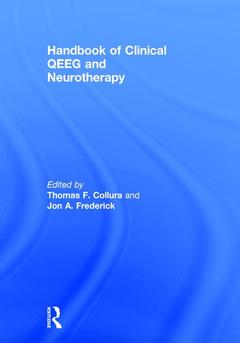Description
Handbook of Clinical QEEG and Neurotherapy
Coordinators: Collura Thomas F, Frederick Jon A.
Language: English
Subject for Handbook of Clinical QEEG and Neurotherapy:
Keywords
Neurofeedback Training; EEG Biofeedback; alpha waves; altered states; Association for the advancement of medical instrumentation (AAMI); auditory or visual stimulation (AVS); Neurofeedback Session; auto spectra; beta waves; brain controlled interfaces (BCI); Brain Master; Brain Mirror; Brain Scapes; concentration/relaxation cycle; cranio-electric stimulation (CES); delta waves; electroencephalograms (EEG); LORETA Neurofeedback; eye movement desensitization and reprocessing (EMDR); GABA; GPRS phase; International Standards Organization (ISO); hypnogogic state; live z-scores; low-resolution electromagnetic tomographic analysis (LORETA); Quantitative EEG; MINI-Q; neurofeedback; percent ZOK; quantitative EEG (QEEG); sensorimotor rhythm SMR; thalamo-cortical reverberations; theta waves; EEG Measure; Alpha Theta Training; Abnormal Coherence; ISNR; QEEG Analysis; CSD; Delta Relative Power; Raw EEG; Transcranial Direct Current Stimulation; Theta Bands; Alpha Relative Power; Peak Frequency Alpha; Restless Legs Syndrome; Lens; Neurofeedback Treatment; TBI; Transcranial Electrical Stimulation; Posterior Cingulate Gyrus; Posterior Cingulate; Clinical Practice
· 17.8x25.4 cm · Hardback
Description
/li>Contents
/li>Readership
/li>Biography
/li>
List of Figures and Tables List of Contributors Preface Introduction I: Clinical Practice of Neurofeedback 1. A Brain Functional Dynamic Approach to Counseling and Therapy Thomas Collura, Christen H. Stahl, Benjamin A. Berry, and Justin R. Leiter-Mcbeth 2.Evolving as a Neurotherapist: Integrating Psychotherapy and Neurofeedback Glenn Weiner 3. Variables Related to Neurotherapy Success/Failure James R. Evans, Mary Blair Dellinger,Ann Guyer, and Jane Price 4. Neuromeditation: An Introduction and Overview Jeffrey M. Tarrant 5.Investigating the Neuroplasticity of Chronic Pain Utilizing Biofeedback Procedures Stuart Donaldson, Mary Donaldson. and Doneen Moran 6. Working with Forensic Populations: Incorporating Peripheral Biofeedback and Brainwave Biofeedback into your Organization or Practice Robert E. Longo and G. Michael Russo II. Pediatric Neurofeedback 7. Training Children Younger than 6 Years of Age Merlyn Hurd 8. QEEG and 19 Channel neurofeedback as a clinical evaluation tool for children with attention, learning and emotional problems Theresia Stöckl-DraxIII: The Neurologist’s Perspective 9. QEEG Guided Neurofeedback to Normalize Brain Function in Various Disorders Jonathan E. Walker 10. QEEG (Brain Mapping) and LORETA Z-score Neurofeedback in Neuropsychiatric Practice. J. Lucas Koberda 11. Concussionology Harry KerasidisIV: Dyslexia and Reading 12. Rhythms of Dyslexia: EEG, ERP & Neurofeedback Tony Steffert and Beverly Steffert 13. Normal and abnormal reading processes in children: Neuropsychophysiological studies Giuseppe A. Chiarenza 14. The Electrophysiological Coordinated Allocation of Resource (CAR) Model of Effective Reading in Children, Adolescents and Adults Kirtley E. Thornton andDennis P. CarmodyV: sLORETA/LORETA and Z-Score Training 15. sLORETA in Clinical Practice: not all ROIs are created equal Mark Llewellyn Smith 16.S-LORETA Neurofeedback as a treatment for PTSD Nir Getter,, Zeev Kaplan, and Doron Todder 17. The Efficacy of Z-Score Neurofeedback Training Joseph Guan 18. Introduction to the Concepts and Clinical Applications of Multivariate Live Z-score Training, PZOK and sLORETA Feedback Penijean A. GracefireVI: QEEG and Brain Dynamical Approaches 19. Perspective and Method for a qEEG Based Two Channel Bi-Hemispheric Compensatory Model of Neurofeedback Training Richard Soutar 20. Neurotherapy for Clinicians in the Trenches: The ClinicalQ and Braindriving Paul G. Swingle 21. The Use of Surface 19-Channel Z-Score Training to Ameliorate Symptoms Remaining or Apparently Caused after Withdrawal from Those Medications Kathy Abbott 22. Raw EEG Biomarkers, Z-Scored Normative Analysis, and the Diagnosis of Neurobehavioral Disorders Leonardo MascaroVII: Traditional Alpha/Theta/Beta Protocols 23. Neurofeedback as a Treatment for Anxiety in Adolescents and Young Adults Cynthia Kerson 24.Alpha-theta-based Clinical Outreach Lincoln Stoller VIII: Emerging Paradigms 25. EEG State Discrimination and the Phenomenal Correlates of Brainwave States Jon Frederick 26. Infra-slow Fluctuation (ISF) Training for Autism Spectrum Disorders MarkLlewellyn Smith, Leo Leiderman and Jackie de Vries 27. Transcranial Direct Current Stimulation in Rehabilitation Roger H Riss and Frederick Ulam 28. An Integrative Approach to Optimizing Neural Function: Exploring the Brain-Gut Connection Nancy E. White and Leonard M. Richards
Thomas Collura, PhD, QEEG-D, BCN, NCC, LPCC, is Clinical Director, the Brain Enrichment Center, and President, BrainMaster Technologies, Inc., in Bedford, Ohio. He is a Past President of the International Society for Neurofeedback and Research (ISNR) and is President of the Association for Applied Psychophysiology and Biofeedback (AAPB).
Jon Frederick, PhD, BCN, serves on the editorial board of Neuroregulation and the board of directors for the Foundation for Neurofeedback and Neuromodulation Research. His current research focuses on mechanisms of learning and the role of explicit processing and attention in physiological self-regulation.




